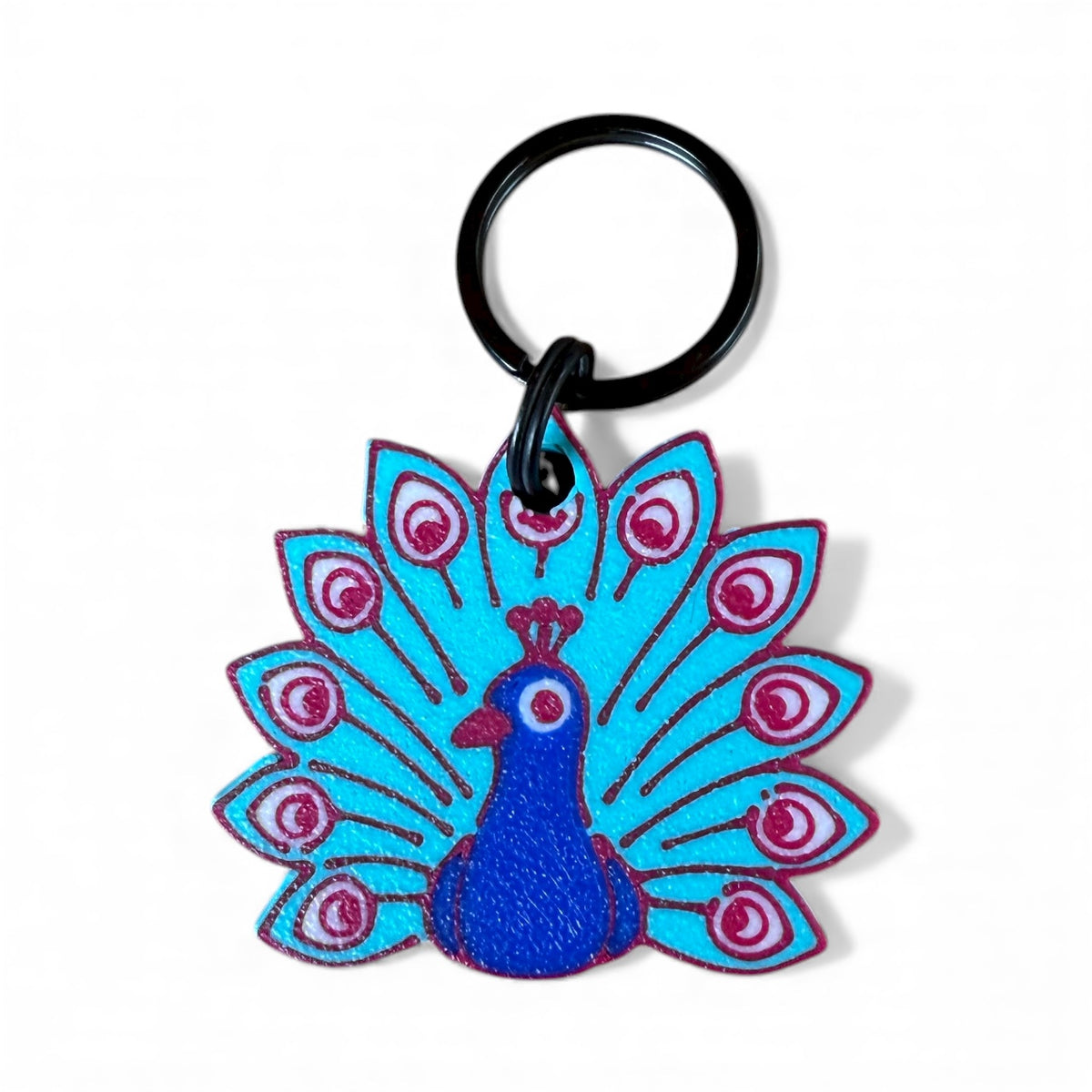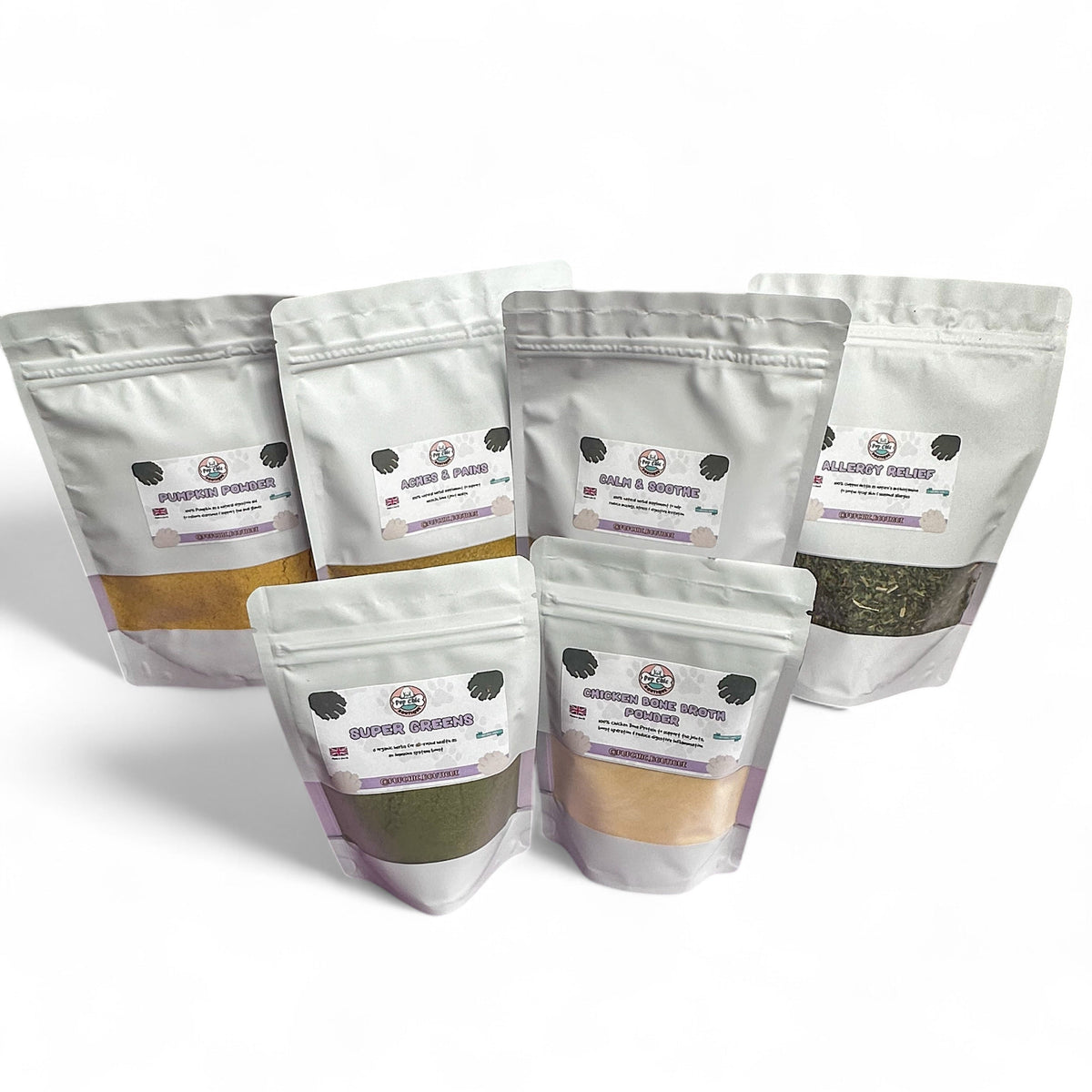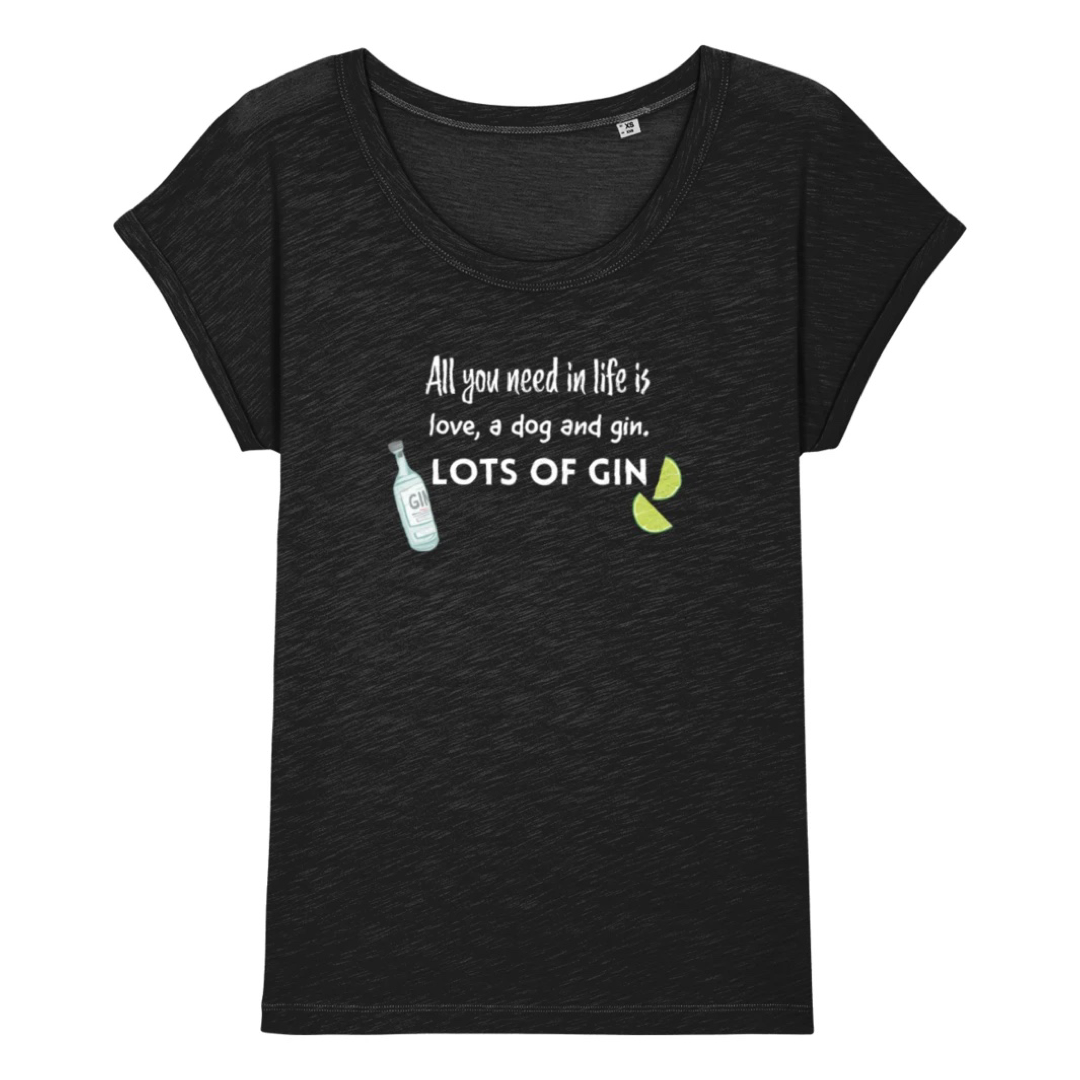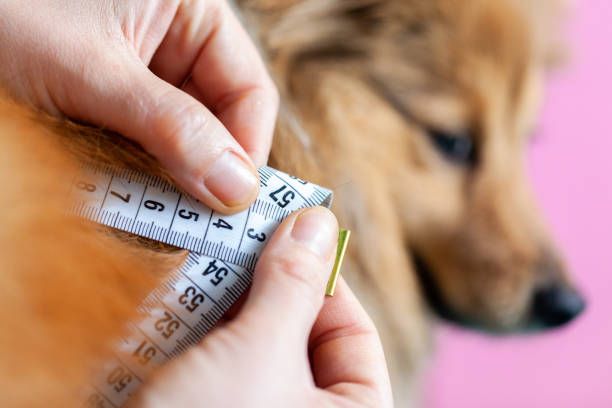 Finding the perfect dog harness can be confusing, especially when every breed has its own quirks and needs. You might expect that one size fits all is enough for your furry friend. The reality is quite different and surprising. Almost 70 percent of harness returns in the UK are due to sizing mistakes which means most owners miss this critical step and risk their dog’s comfort and safety. The right fit doesn’t just look better. It actually helps prevent injuries, and even stubborn pups become happier walkers once their harness suits their body shape. At Pup Chic Boutique you can always reach out to us with your dog’s breed, neck and chest measurements and we will tell you the right size harness. DM us on social media or email hello@pupchic.boutique.
Finding the perfect dog harness can be confusing, especially when every breed has its own quirks and needs. You might expect that one size fits all is enough for your furry friend. The reality is quite different and surprising. Almost 70 percent of harness returns in the UK are due to sizing mistakes which means most owners miss this critical step and risk their dog’s comfort and safety. The right fit doesn’t just look better. It actually helps prevent injuries, and even stubborn pups become happier walkers once their harness suits their body shape. At Pup Chic Boutique you can always reach out to us with your dog’s breed, neck and chest measurements and we will tell you the right size harness. DM us on social media or email hello@pupchic.boutique.
Table of Contents
Quick Summary
| Takeaway | Explanation |
| Accurate sizing is crucial for comfort | A well-fitting harness ensures your dog’s comfort, preventing skin irritation and allowing for natural movement during walks. |
| Different breeds require specific designs | Each breed has unique body shapes; harnesses must accommodate these differences for optimal fit and function. |
| Measure your dog correctly before buying | Use a flexible tape measure to get accurate neck and chest measurements, ensuring the harness fits properly. |
| Select adjustable harnesses for growing puppies | Choose harnesses with multiple adjustments to accommodate a puppy’s rapid growth, ensuring long-term usability. |
| Enhance harness acceptance with positive reinforcement | Introduce the harness gradually with treats and praise, ensuring your dog associates it with positive experiences. |
Why Harness Sizing by Breed Matters
Choosing the right harness for your dog isn’t just about style—it’s a critical decision that impacts your furry friend’s comfort, safety, and overall well-being. Every breed has unique body characteristics that demand precise sizing and fit, making a universal approach to harness selection ineffective. Whilst there are many breeds that fit into one size harness, for example, if you told me you had a miniature Dachshund, at Pup Chic Boutique I’d be able to tell you that your dog will wear a size XS harness and fit all style harnesses we have in this size. But there are some that can cross over multiple sizes, for example Chihuahuas, at Pup Chic we have customers ranging from a XXXS to a small for Chihuahuas. And then crossbreeds can totally vary too, Cockapoos for example can vary from a XS to a large harness.
The Health Implications of Improper Harness Sizing
An incorrectly fitted harness can cause significant health problems for your dog. The American Kennel Club emphasises that poorly sized harnesses can lead to serious issues beyond mere discomfort. These problems range from skin irritation and chafing to potential musculoskeletal complications.
When a harness doesn’t fit properly, it can create uneven pressure points on your dog’s body. This uneven distribution can cause rubbing against sensitive areas, potentially leading to painful sores or restricted movement. Breeds with different chest sizes and body shapes—like a muscular Bulldog versus a lean Greyhound—require specific considerations to ensure optimal comfort and protection.
Breed-Specific Sizing Challenges
At Pup Chic we have highlighted that each breed presents unique sizing challenges. A harness that works perfectly for a compact Toy Poodle will likely be completely unsuitable for a large Mastiff. Compact breeds need harnesses that provide secure coverage without overwhelming their small frames, while larger breeds require robust designs, with longer length harnesses that can support their weight and movement.
Consider the anatomical differences: a Dachshund’s long body requires a different harness design compared to a broad-chested Boxer. The harness must accommodate the breed’s specific body shape, ensuring it doesn’t restrict natural movement or breathing. A well-fitted harness should allow full range of motion while providing secure control during walks.
Safety and Control Considerations
Proper harness sizing isn’t just about comfort—it’s fundamentally about safety. The National Association for the Advancement of Animal Welfare advises that an incorrectly sized harness can compromise your ability to control your dog effectively. A harness that’s too loose might slip off, while one that’s too tight can cause breathing difficulties and potential injury.
For active dogs or those in training, a precise fit becomes even more critical. The harness should allow for easy movement while providing enough control to prevent sudden escapes or unexpected lunging. This balance is particularly important for breeds with high energy levels or those prone to pulling, such as Huskies or working dogs.
By understanding and respecting the unique physical characteristics of different dog breeds, you can select a harness that not only looks great but provides maximum comfort, safety, and functionality. Taking the time to measure accurately and choose breed-appropriate sizing is an investment in your dog’s health and happiness.
Dog Harness Size Chart by Popular Breeds UK
Navigating dog harness sizes can feel like solving a complex puzzle, especially when considering the diverse range of dog breeds found across the UK. Understanding the nuanced sizing requirements for different breeds ensures your furry companion stays comfortable, secure, and stylish. At Pup Chic we have created this size chart by breed based on our customers, we have also included rough weigh guides, however weight does not always match up to harness size, so it is always important to measure your dog’s neck and chest measurements to ensure you are getting the right size harness.
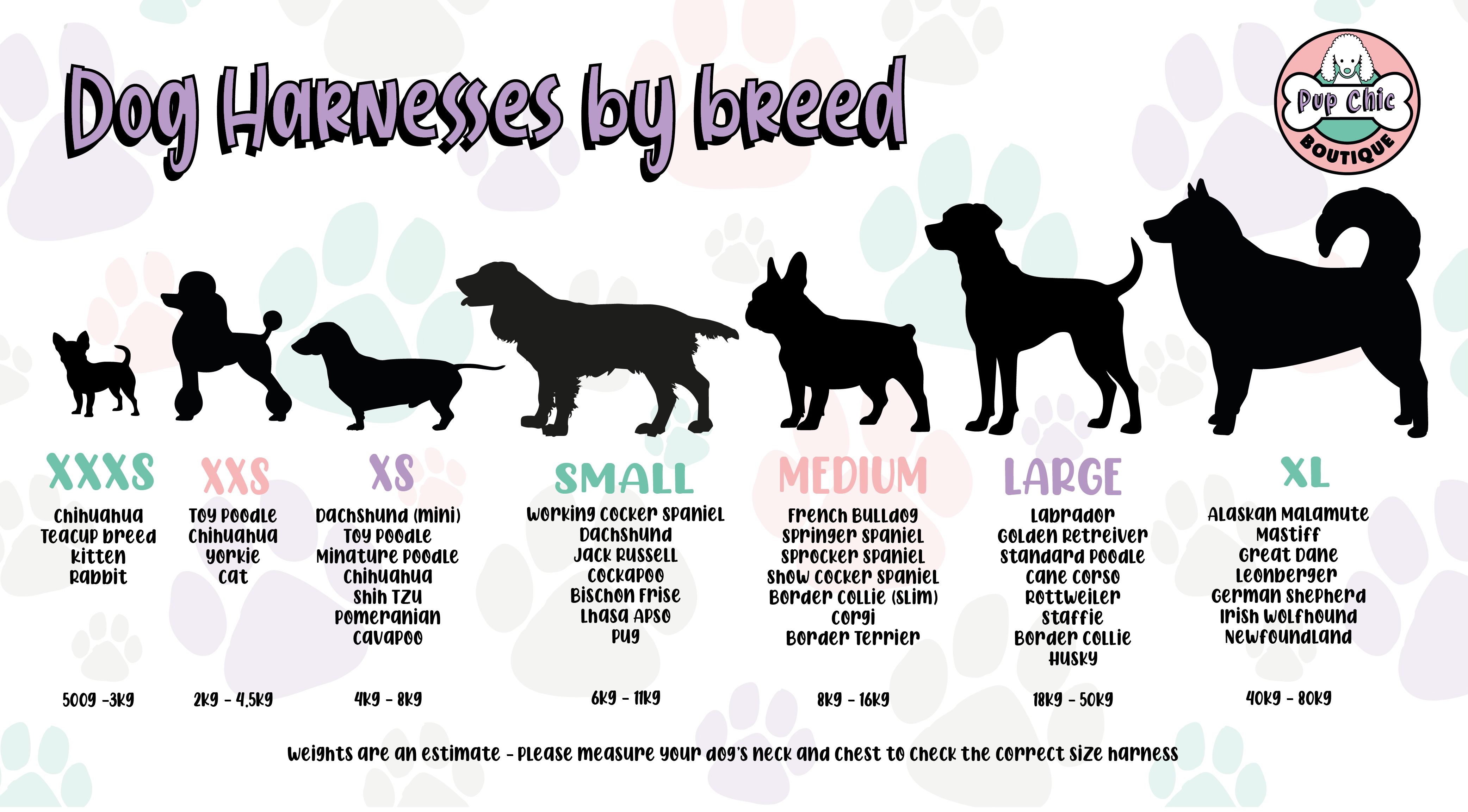
Small Breed Harness Sizing
For petite pups weighing under 10 kg, precise sizing becomes crucial. Our breakdown by breed provides detailed insights into sizing for a variety of breeds for a puppy and adult. Chihuahuas, Yorkshire Terriers, and Toy Poodles typically require XXXS-XXS harnesses with chest girths ranging from 20-38cm. These tiny companions need harnesses that offer snug protection without overwhelming their delicate frames.
Breeds like Shih Tzus and Miniature Dachshunds often fall into the XS category, requiring harnesses with slightly larger measurements. With smaller breeds, it['s important to ensure a secure fit that prevents escape while maintaining comfort during walks.
Medium Breed Harness Specifications
Medium-sized dogs represent a diverse group with unique sizing requirements. Breeds such as Cocker Spaniels, Border Collies, and Beagles typically need harnesses that accommodate their athletic builds.Whilst they are medium size breeds, they can vary in harness sizes from a small to a large.
Strong breeds prone to pulling like Staffies, Working Cockers and Boxers demand harnesses that provide robust support without restricting movement. Key considerations include chest width, muscle definition, and individual body shape variations within the breed. Our tactical harnesses at Pup Chic have a longer and thinner chest so they won’t cause friction against the legs and allow for free movement of the joints so they can comfortably walk and run.
Large Breed Harness Considerations
Larger breeds like Labrador Retrievers, German Shepherds, and Rottweilers need harnesses that can handle their substantial weight and energy. We recommend size large in our tactical style harnesses for these powerful dogs, focusing on distributing pressure evenly and providing maximum control.
For dogs weighing between 18-50 kg, a harness with a neck circumference around 47-68cm and chest circumference of 52-92cm works best. These harnesses must balance durability with flexibility, allowing natural movement while preventing pulling and ensuring owner control.
Whilst larger breeds that weigh between 45-80kg like Alaskan Malamutes and Mastiffs will require an XL dog harness with a neck circumference around 59-89cm and chest circumference of 59-104cm.
When selecting a harness, remember that individual dog measurements can vary significantly within breed standards. Always measure your dog’s chest girth, neck circumference, and body length for the most accurate fit. Breed guidelines provide an excellent starting point, but individual variation means personal measurement is key to finding the perfect harness.
Consult breed-specific sizing charts, measure carefully, and consider your dog’s unique body shape. A well-fitted harness isn’t just about comfort—it’s about ensuring your dog’s safety, security, and freedom to explore the world by your side.
To help you compare the harness sizing requirements for different breed categories, here is a summary table that organises the key points discussed for small, medium, and large breeds:
| Breed Size | Typical Breeds | Example Harness Size | Key Sizing Notes |
| Small | Chihuahua, Yorkie, Toy Poodle, Jack Russell | XXXS to Small | Chest girth 8–10 inches; secure harness without overwhelming small frame |
| Medium | Cocker Spaniel, Border Collie, Beagle, Boxer | Size Small to Large | Neck 50cm, body 34–47cm; robust design for athletic build |
| Large | Labrador, German Shepherd, Rottweiler, Alaskan Malamute, Mastiff | Size Large or XL | Neck 55–60cm, body 47–62cm; distribute pressure evenly, allow movement |
How to Measure Your Dog for a Harness
Measuring your dog for a harness is a precise process that requires patience, accuracy, and the right technique. Getting the perfect fit ensures your dog’s comfort, safety, and freedom of movement during walks and adventures.
Essential Measuring Tools and Preparation
WikiHow recommends gathering specific tools before starting your measurement process. You’ll need a flexible measuring tape, a calm environment, and your dog’s cooperation. Soft fabric measuring tapes work best, as they can easily conform to your dog’s body contours.
Prepare your dog by choosing a time when they’re relaxed and calm. Have treats ready to make the measuring process positive and enjoyable. Ensure your dog is standing naturally, with their weight evenly distributed. Avoid measuring immediately after exercise when your dog might be panting or slightly swollen.
Key Measurement Points
The North American Institute for Dog Safety provides detailed guidance on critical measurement points. The three most important measurements are neck circumference, chest girth, and body length.
To measure neck circumference, wrap the measuring tape around the base of the neck where a collar would normally sit. Ensure you can comfortably slide two fingers between the tape and your dog’s neck to guarantee proper fit. For chest girth, measure the widest part of your dog’s chest, typically just behind the front legs. This measurement is crucial for preventing chafing and ensuring the harness stays securely in place.
Body length measurement involves calculating the distance from the base of the neck to the base of the tail. This helps determine whether the harness will provide adequate coverage and support for your dog’s specific body shape.
Troubleshooting Common Measurement Challenges
Koda Dog Training offers insights into handling measurement challenges. Dogs with thick fur or unusual body shapes can make precise measuring tricky. For furry breeds, part the coat and measure as close to the skin as possible to get an accurate reading.
If your dog is particularly wriggly or uncooperative, try measuring in stages. Use treats and gentle praise to keep them calm. Consider having a second person help by gently holding and distracting your dog while you take measurements. For more active or anxious dogs, multiple short measuring sessions might be more effective than one long attempt.
Remember that harness sizes can vary between brands. Always check the specific sizing chart for the harness you’re considering. When in doubt, it’s typically safer to choose a slightly larger size that can be adjusted down, rather than a harness that’s too tight and restrictive.
Take your time during the measuring process. Rushing can lead to inaccurate measurements and an ill-fitting harness. A well-fitted harness is more than just a piece of equipment—it’s a critical safety tool that ensures your dog’s comfort and your peace of mind during every walk and adventure.
For an easy reference, here is a table outlining the essential steps and considerations when measuring your dog for a harness, as discussed in the article:
| Step | Description |
| Preparation | Gather a soft tape measure; ensure calm environment and relaxed dog |
| Neck Circumference | Measure at base of neck, allowing two fingers for comfort |
| Chest Girth | Measure widest part behind front legs; prevents chafing and slipping |
| Body Length | Measure from base of neck to base of tail; ensures proper harness cover |
| Troubleshooting | For thick fur, part coat; use treats; measure in short sessions if needed |
| Double-Check Size | Compare with specific brand’s size chart before buying |
Tips for New UK Puppy Owners Choosing Harnesses
Bringing home a new puppy is an exciting journey filled with learning and bonding. Selecting the right harness is a crucial step in ensuring your furry friend’s comfort, safety, and enjoyment during walks and adventures.
Understanding Puppy Harness Basics
Dogs Trust provides essential guidance for introducing harnesses to young dogs. The key is creating positive associations from the very beginning. Start by leaving the harness near your puppy’s favourite spaces, allowing them to investigate and become familiar with the new item without pressure.
When first introducing the harness, use treats and gentle praise to make the experience enjoyable. Place treats around and through the harness, allowing your puppy to develop a positive connection. This approach helps prevent future resistance and makes wearing the harness a pleasant experience.
Selecting the Right Harness for Puppies
Since puppies grow rapidly, choose a harness with multiple adjustment points to accommodate their changing body size. Measure the chest circumference carefully, using the finger placement method: two fingers behind the front legs for smaller puppies, ensuring a snug but not restrictive fit. All the harnesses at Pup Chic are adjustable and we also offer a 20% puppy upgrade when you need to get the next size up harness for your puppy.
Consider your puppy’s breed and expected adult size when selecting a harness. Some harnesses offer adjustable designs that can grow with your puppy, you may even be able to skip a size harness for larger breeds that grow quickly, potentially saving you money in the long term. For example, if your puppy starts in a size small in a Pup Chic tactical dog harness, you may be able to skip a size medium and go straight from the small to a large based on the adjustment sizes. Look for lightweight materials that won’t overwhelm your young dog and provide freedom of movement.
Harness Training and Comfort Strategies
Ordnance Survey highlights the importance of comfort and proper fit. A well-fitted harness should allow a pinky finger to slide between the harness and your puppy’s body. This ensures the harness is secure without being too tight, preventing potential chafing or restriction of movement.
Training your puppy to accept the harness requires patience and consistency. Start with short wearing sessions indoors, gradually increasing duration. Reward your puppy with treats and praise during and after harness time to create positive associations. If your puppy shows signs of discomfort, pause and reassess the fit or try a different style.
Remember that each puppy is unique. What works for one might not work for another. Be prepared to experiment with different harness styles and brands until you find the perfect match. Pay attention to your puppy’s body language and comfort level, adjusting as needed.
Choosing the right harness is more than just a purchase—it’s an investment in your puppy’s comfort, safety, and future walking experiences. Take your time, be patient, and approach the process as another opportunity to bond with your new furry companion.
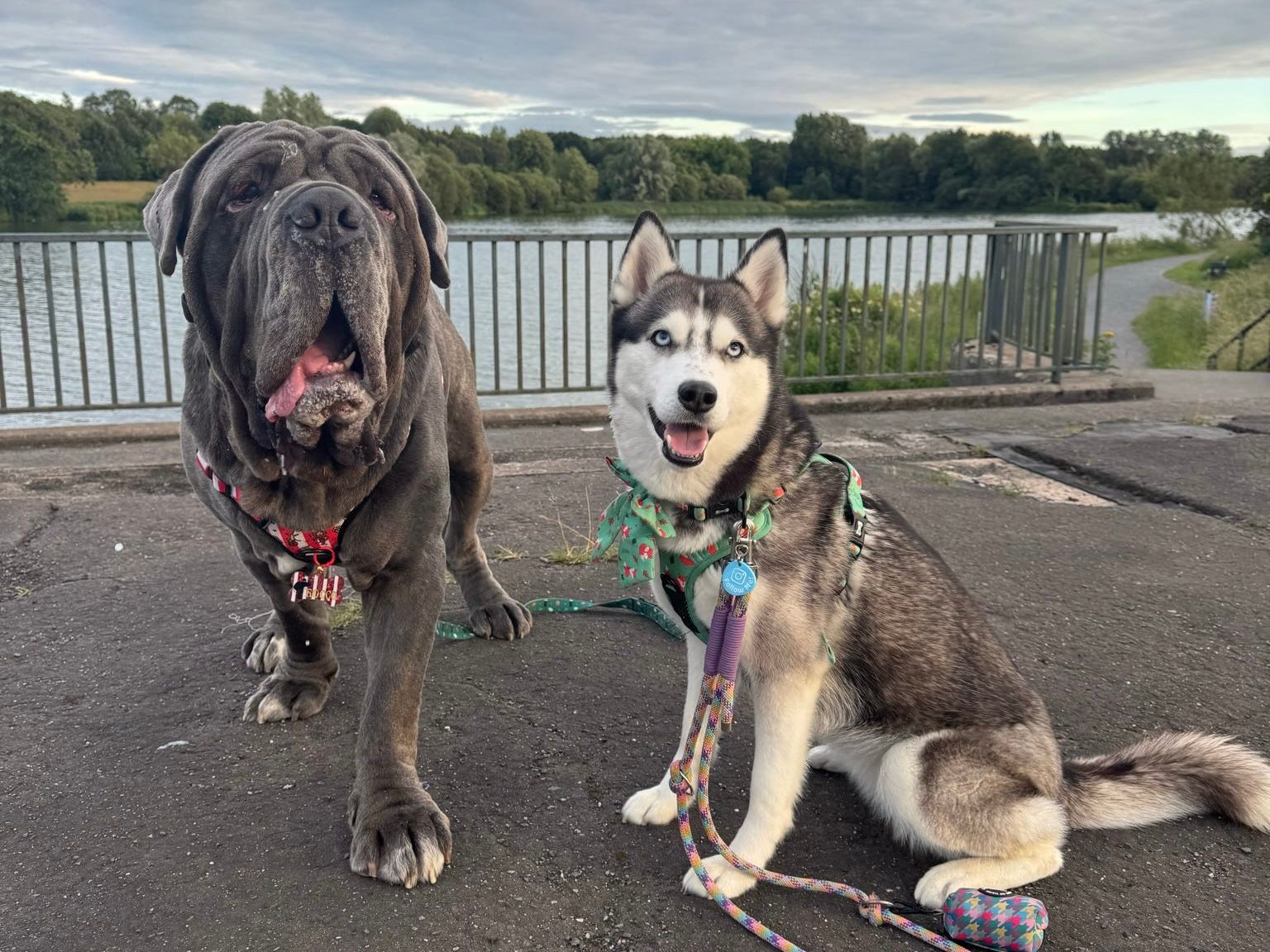
Frequently Asked Questions
What size harness should I buy for my dog?
Selecting the right size harness depends on your dog’s breed and specific measurements. Measure your dog’s neck circumference, chest girth, and body length to ensure a proper fit. Each breed has unique sizing requirements, so refer to a breed-specific harness size chart for guidance.
How do I measure my dog for a harness?
To measure your dog, you’ll need a flexible tape measure. Measure the neck circumference at the base of the neck, the chest girth at its widest part, and the body length from the base of the neck to the base of the tail. Ensure your dog is standing naturally for accurate measurements.
Why is it important to have a properly fitted harness?
A properly fitted harness is crucial for your dog’s comfort and safety. An ill-fitting harness can cause skin irritation, restrict movement, and compromise control during walks. It helps prevent injuries and ensures your dog feels secure while wearing it.
Can I use the same harness for my growing puppy?
While you can use a harness for your growing puppy, it’s advisable to choose one with multiple adjustable points to accommodate changes in size. Ensure to measure your puppy frequently and adjust or replace the harness as needed for optimal comfort and fit.
Find the Perfect Fit for Your Dog with Pup Chic Boutique
Struggling with harness sizing and worried about your dog’s comfort and safety? As discussed above, an ill-fitting harness can mean irritation, escapes or even health risks for your beloved dog. Our readers often mention the stress of measuring, breed-specific challenges and the disappointment of ordering the wrong size. You deserve a stress-free solution, where style meets practical fit for every breed and body type. Feel the difference when you choose a harness engineered with genuine UK craftsmanship and inspired by what real dog mums need.
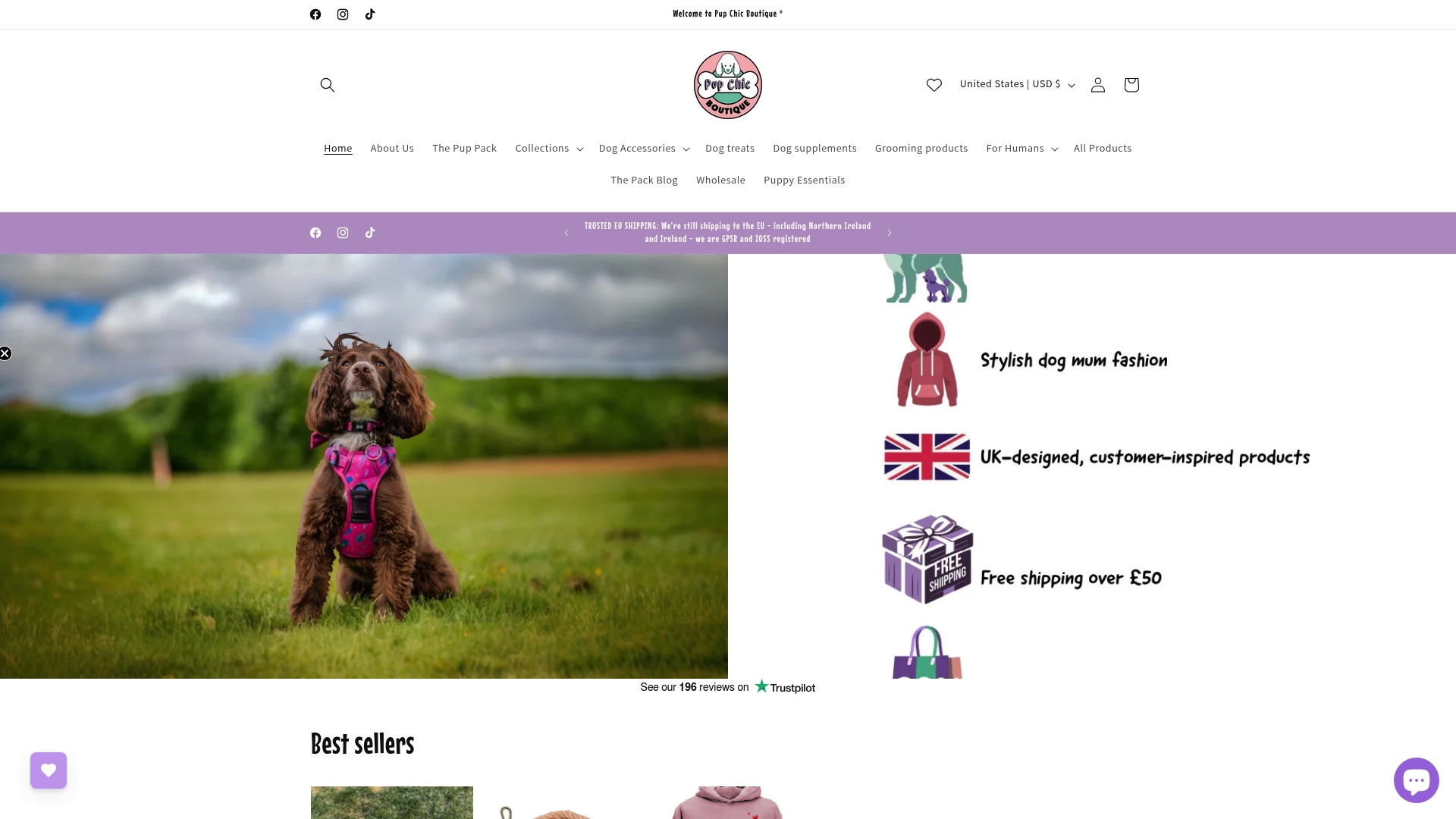
Say goodbye to sizing guesswork. Explore Pup Chic Boutique for a handpicked collection of high-quality no-pull harnesses, accessories and matching sets for you and your pup. Shop now to give your dog a harness that fits just right, backed by thoughtful advice and fast UK delivery. Visit our homepage today and make every walk more comfortable and secure.
Recommended
-
The Ultimate Guide to Comfort and Safety: Adjustable Harnesses for Ner – Pup Chic Boutique
-
Plumcious corduroy dog harness - adjustable dog harness – Pup Chic Boutique
-
City Slicker grey vegan leather dog harness - adjustable dog harness – Pup Chic Boutique
-
[
How to Choose Service Dog: A 2025 Guide for Owners & Handlers
– iPupPee](https://ipuppee.com/blogs/news/how-to-choose-service-dog-2025-guide)
